 Naval Resistance to Britain's Growing Power in India, 1660–1800
Naval Resistance to Britain's Growing Power in India, 1660–1800 Book contents
- Frontmatter
- Contents
- List of Illustrations
- Abbreviations
- Chronology
- Maps
- Preface
- Part I Early Naval Resistance: The Historical Background
- Part II The Saffron Banner: Irregular Naval Warfare against an Emergent Britain
- Part III The Tiger of Mysore: A Conventional Navy to Oppose British Dominance
- Conclusion
- Bibliography
- Index
- Worlds of The East India Company
4 - Alibag: Fleet Base of the Maratha Northern Command
Published online by Cambridge University Press: 23 February 2023
- Frontmatter
- Contents
- List of Illustrations
- Abbreviations
- Chronology
- Maps
- Preface
- Part I Early Naval Resistance: The Historical Background
- Part II The Saffron Banner: Irregular Naval Warfare against an Emergent Britain
- Part III The Tiger of Mysore: A Conventional Navy to Oppose British Dominance
- Conclusion
- Bibliography
- Index
- Worlds of The East India Company
Summary
Earlier, Alibag was known as ‘Kolaba’, attributed to the Kolaba Fort which was built by Shivaji the great, in 1680. Legend has it that a wealthy Muslim named Ali owned many plantations and it is from him that the town derived its name Alibag.
Modern-day guide to India
The naval war fought between the Siddis and Marathas and which continued into the first decade of the eighteenth century created for the Presidency of Bombay an undeserved illusion of safety. If these two powerful indigenous forces were determined to channel their energies upon attempting to annihilate each other, EIC possessions along the Indian coastline would be relatively secure from acts of hostility. Strengthening this illusion was not only the death of Bhosale Shivaji in 1680 but the failure of his immediate successors, Sambhaji (1681–89) and Rajaram (1680–1700), to show the same level of military prowess as Shivaji. Sambhaji, Shivaji’s eldest son, fought a desultory campaign against the seemingly infinite forces assembled by the Mughals, culminating in his capture and execution by Aurangzeb. As for Rajaram, a younger son of Shivaji, he spent most of his reign trapped in the far south of the Deccan by far superior Mughal forces. During this failed leadership period, the empire created by Shivaji began to splinter, with the fight against the Mughals pursued instead by a number of individual chiefs. However, none of this should have resulted in a high level of complacency that affected the newly created Presidency and Council of Bombay. Instead of overseeing a programme of improving the defences of the archipelago, they continued to rely upon those that had so easily fallen to the Siddis during the final months of 1686. Clement Downing, an employee of the Company who subsequently wrote his observations of Bombay following his arrival at the port in 1715, made reference to its defensive weaknesses, describing it as ‘unwalled’ and having ‘no grabs or frigates to protect anything but the fishery; except a small Munchew [possibly a gallivat]’.
Yet Bombay should have been on its guard. Along the Konkan, the Maratha territory that lay closest to the archipelago, something was stirring. Here relative stability prevailed with the coastline being fortified and prepared for a future war with the EIC.
- Type
- Chapter
- Information
- Naval Resistance to Britain's Growing Power in India, 1660–1800The Saffron Banner and the Tiger of Mysore, pp. 61 - 79Publisher: Boydell & BrewerPrint publication year: 2014


